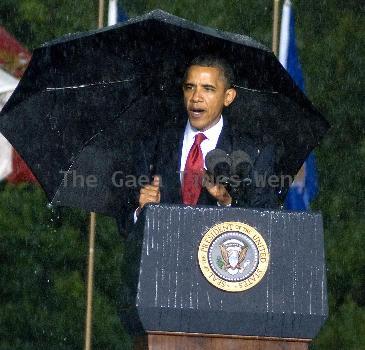Doubts have been raised about accuracy of estimates on how much is gushing from BP well
By H. Josef Hebert, APWednesday, June 9, 2010
Gov’t: BP mow capturing 630,000 gallons of oil.
WASHINGTON — The amount of crude captured from the gushing BP oil well grew to 630,000 gallons a day on Wednesday, putting into further doubt the validity of government estimates on how much oil actually is spewing into Gulf waters.
That would be more than half of the upper range that the government has said is coming from the damaged wellhead a mile beneath the sea and would far exceed what has been the conservative lower-range estimate of just over 500,000 gallons a day.
Coast Guard Adm. Thad Allen, who is in charge of the spill response effort, acknowledged at a briefing Wednesday — where he produced the latest oil recovery numbers — that he expects a fresh analysis of the flow rate to produce more accurate estimates on how much oil is being released.
Allen said “we continue to make progress” in capturing more of the oil and that the amount of crude being diverted could nearly double by next week as processing of the captured oil is expanded.
“We’ll be at 28,000 (barrels) by next week. We’re building capacity,” said Allen. That would mean 1.17 million gallons of oil a day would be captured, far more than what up to now has been the upper range of the government’s estimated flow rate.
The inability to pin down how much oil is gushing from the BP well a mile beneath the water’s surfacer has stymied government officials almost from the day of the accident April 20.
“I’m not going to declare victory on anything until I have absolute numbers,” said Allen on Wednesday.
At a Senate hearing, meanwhile, Interior Department officials — like Allen — expressed confidence that more precise numbers on the flow rate will be available from a special task force of scientists, which is nearing completion of a review of earlier flow data and has been provided new high-resolution video.
“We expect to have a much better estimate (of oil flow) very soon,” Deputy Interior Secretary David Hayes told senators at a hearing by the Senate Energy and Natural Resources Committee.
The task force earlier estimated that 500,000 to 1 million gallons a day are flowing from the broken wellhead, but Hayes said those numbers assume “a lot of uncertainty.” Some independent scientists long have said the flow is almost certain to be higher.
Meanwhile, Allen acknowledged that the amount of oil now being captured is close to exceeding the capacity of the processing ship that is on site. But he said a second vessel, where oil can be both stored and flared, is expected to be available soon. And an even larger vessel from the North Sea also is heading to the oil spill site.
With oil expecting to gush for another two months, Allen said he wants a long-term containment strategy from BP “with built in redundancies” that would taken into account new risks posed by the upcoming hurricane season.
He said a huge, 1,000-foot-long vessel being brought in from the North Sea is similar to a production platform that can “lock into position” of the water surface and provide greater stability as it processes oil flowing from the damaged wellhead.
Allen also noted that he and other officials are meeting with BP later Wednesday to discuss problems with the handling of damage claims related to the April 20 accident.
He said claims brought by individuals for loss of business as a result of oil contamination “sometimes (is) hard to get a handle on” but that he will discuss the issue with BP officials to try to speed up the process.
Some senators, meanwhile, expressed concern over the impact the response to the spill will have on oil development.
Testifying before the Senate energy panel, Interior Secretary Ken Salazar sought to reassure lawmakers that the Obama administration has pressed a “pause button, not the stop button,” on all offshore oil drilling in the Gulf of Mexico and elsewhere.
Salazar described the recent moratorium that President Barack Obama put in place for offshore deep-water drilling, along with new requirements for shallow water oil drilling. The moratorium affects 33 deep-water drilling rigs, but does not halt oil production from existing production wells.
While many Gulf residents are reeling from the economic impact of the oil spill on fishing and tourism, the region also relies heavily on paychecks from the oil industry and these workers are worried about their economic futures.
Sen. Mary Landrieu, D-La., told Salazar the drilling moratorium threatens hundreds of oil industry jobs and could result in “economic havoc” and be “devastating to our state and to the Gulf Coast.”
Salazar said the administration wants to make sure that drilling can be done in a way “that is protective of the people and the Gulf region.” He said the drilling pause will be in place “until we can have a sense of safety, until we have a sense that this (kind of spill) can never happen again.”
At another hearing, the Senate Environment and Public Works Committee took testimony on legislation that would raise the federal oil spill liability cap from $75 million to $10 billion.
Kenneth Murchison, a law professor at Louisiana State University, told the lawmakers there are “economic and more arguments” for raising the cap. Holding back his emotions, Murchison, born in Louisiana with deep roots in the state, said he is “dismayed by the horrific damages” done by the oil spill.
Opponents of the cap increase argued that the federal limit does not affect unlimited liability under state law, but raising it to $10 billion would unfairly impact smaller oil companies.
Tags: Accidents, Barack Obama, Energy, Environmental Concerns, Government Regulations, Industry Regulation, Legislature Hearings, Louisiana, North America, United States, Washington

